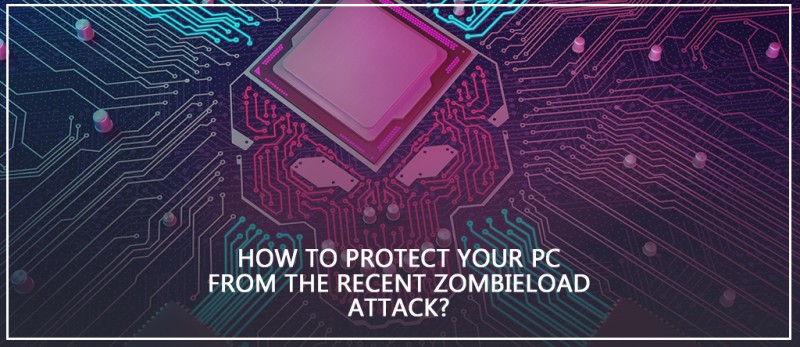Run for your life as the dead rise yet again from their graves. No, not the decaying human corpses you see on television. Worse, it’s your deleted browsing history, your sensitive application information, your private execution environments, your essential user data, and whatnot—resurrected from the depths of your CPU’s Intel chip, and laid bare for the hackers to take advantage of.

This internal crisis is reported to hit processors with generations dating back to 2011. So, it’s an actual the zombie apocalypse in the technological domain, rightfully termed as ‘ZombieLoad’ for the fearing geeks out there.
This new Intel vulnerability is similar to last year’s Spectre, Meltdown and other side-channel attacks. Why? Because it hits the hardware directly, right during the ‘speculative execution’ process.
ZombieLoad abuses this performance optimization technique (which undertakes inferred tasks beforehand that may be needed in the future to reduce any sort of delay in the execution later on—for a smoother and faster functioning) by creating a window for data leakage.
The method of attack has been termed as ‘Microarchitectural Data Sampling’ (MDS). The targeted small structures of the chip include store buffers, line fill buffers, load buffers, and uncacheable memory, existing between the chip’s components.
In other words, ZombieLoad allows a third party program to read, sample and siphon data from inside the CPU’s chip that otherwise is not accessible, bypassing the user and the external security shields easily.
What’s worrying is that this attack affects each and every single device which runs on an Intel chip, from a desktop PC to a Chromebook.
And, since you’re stuck with this hardware-vulnerability which literally steps over you (being pre-authenticated and a malware-wormhole), what exactly can you do about it? Let’s see.
Update your Systems
How do you fix a hole? Through a solid patch. That’s exactly what the tech companies are working on, as we speak. A high-end critical patch to sabotage the ravages of the ZombieLoad attack.
This software patch will probably be released through the incoming flurry of updates, which you’d have to download ASAP if you wish to secure your processor and its internal components.
Most of the current devices are tuned to accept and install system updates automatically over a safe network. However, in case the auto-download feature is turned off, you can bring your PCs up to the level by following these steps:
- For Google ChromeOS—Although, your Chromebook should give you the notifications for the pending app/system updates in the lower right corner of the screen, still, you can inspect the updating status yourself by clicking the small gear icon in this notification panel and heading to the Chrome’s settings. In the newly opened window, tap the hamburger-looking icon in the top left corner. From there, ‘About Chrome OS’ > ‘Google Chrome OS’ > ‘Check for Updates’. Once the download & the installation is done, restart your Chromebook with fresher security reinforcements against ZombieLoad.
- For Microsoft Windows 10—Head to the ‘Start’ menu and begin typing ‘updates’. Windows will perceptively highlight the option ‘Check for Updates’ for you. Click on that and you’ll be directed to a new folder in the settings, going by the name of ‘Windows Updates’, where you can see if there are any pending updates that haven’t already been downloaded. Give them a go and then restart your system upon completion. Tweak the advanced settings to your liking (make sure to enable the auto-download option in there), change the ‘Active Hours’ and view the ‘Update History’. Just make sure to supercharge your PC the right way.
- For Apple MacOS—The top left corner of your screen will show an apple icon. Click on it and from among the options, choose ‘System Preferences’. Next, go to the ‘Software Update’ function by hitting the gear-like icon. This will give your OS the signal to check for updates. If there are any, an ‘Update Now’ button will pop up, which you can enable and thereby, download + install the latest vulnerability patch in your Apple macOS. Moreover, the advanced settings will give you the personally preferable options for the updating procedure. Once there, make sure to keep “Automatically keep my Mac up to date” in the green.
Choose to Disable Hyper-Threading
‘Hyper-Threading’ is an elemental feature of the Intel processor which enables it to wind up multiple tasks at once with unforeseen speed and performance.
You can guess how it contributes to the speculative execution operation. So, disabling it at the cost of performance might just offset the attack. Tech companies are taking different approaches to this hit.
According to an article on The Verge, Apple seems to be delegating the decision to the consumers by leaving the feature on default-wise, Google’s taking the high road by turning off the feature by default, and Microsoft is fuzzing in between.
The point is, you have to choose between security and performance when it comes to hyper-threading, and that’s not an easy decision to make.
Regardless, the aforementioned pointers, once followed with care, can help you protect your PCs against the latest ZombieLoad attack, warding off the tech-pocalypse for sure.
Leave a Reply